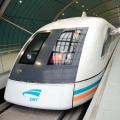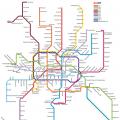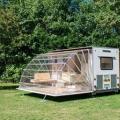The following structural elements are distinguished:
1. Geosynclinal regions(or folding zones). The name of the structure comes from the Greek words: geo - Earth and sinklino - lean. These are tectonically mobile vast areas crust stretched for tens, hundreds and thousands of kilometers. The formation of geosynclinal regions begins with a long trough of the deep ocean floor between continents or along the junction of the ocean floor with the mainland. Under the weight of the accumulation of marine sediments, the trough approaches the upper mantle (asthenosphere). This is accompanied by the formation of cracks and faults, along which the trough penetrates from the mantle into the earth's crust. These intrusions contribute to the transformation of the trough in the earth's crust, their metamorphization and the formation of ore deposits. Then the folding process begins, accompanied by the rise of individual sections of the deflection. The rise leads to the formation of a row. The process ends with the formation of powerful folded areas. Mountainous countries correspond to geosynclinal regions. Thus, the original deflections are transformed into folded mountain structures. The earth's crust in them becomes especially powerful and complexly dissected.
Patient Safety Education for Medical Student Students: Priority Areas for Curriculum Development. Compensation as a duty of care: case Not to blame. Asserting Behavior in a Waste Medical Injury System: A Descriptive Analysis of Applicants and Non-Applicants.
The future of patient negligence litigation? New Zealand Medical Injury Compensation: “Not Fault” to Increase Claims and Reduce Social and Clinical Selectivity? Avoidable Medical Injury in a No Failure Hospital in New Zealand. Donaldson, Liam; Philip, Pauline. Patient safety is a global priority.
With the extinction of mountain building Mountain country under the influence of exogenous processes, it gradually collapses and turns first into a peneplain (almost), and then into a plain. Over time, geosynclinal areas transform into a platform.
2.Platforms(French plate-forme - flat form). These are vast, sedentary areas of the earth's crust (only done). The platforms create a solid frame for the earth's crust. They have a two-tiered structure. The upper layer (cover) is composed of calmly lying sedimentary rocks, lying horizontally or crumpled into gentle folds by subsequent movements of the earth's crust. These sedimentary rocks can be marine and continental type, which indicates the slow vertical vibrations that the platform makes. The thickness of the sedimentary cover is relatively small - 3-4 km.
Under the cover is the lower tier of the platform, called the foundation. It is strongly folded into folds in previous geological periods, has various disseminations of magma and consists of folded metamorphosed rocks. The platform foundation is a remnant of the geosynclinal area. Sometimes part of the platform basement rises to the level of sedimentary rocks of the platform cover or above these loose deposits. Such a platform structure is called a shield (South American (Brazilian), Chinese, Indo-Chinese, African-Arabian,;
b) young platforms... At these platforms, not only Precambrian, but also Paleozoic rocks (the result of the Caledonian and Hercynian folding) are crumpled into folds - the platform.
c) There are platforms that have not yet taken shape completely and represent the transition from the geosynclinal stage to the platform stage. They have not yet had time to form a platform cover over the folded foundation. Such platforms are simply called areas of Mesozoic folding.
Extensive areas of platforms covered with thick strata (10 to 16 km) of sedimentary rocks are called plates. For example, the West Siberian plate, the Polish-German plate. Plates in geological history were formed later than ancient platforms. In the relief, the platforms and the plains correspond.
The surface of the platform foundation is not always even, it forms gentle deflections () and uplifts (). The troughs and uplifts are covered with a sedimentary cover of varying thickness.
3.Edge deflections.
Foredeeps are often located between geosynclines and platforms. They were formed as a result of the rise of mountains on the border with the platform. Foredeeps are complex in structure, reaching 15-17 km in depth, and their length is often equal to the length of the mountain structure. They are usually filled with sediment that builds up here as a result. These rocks slide down the slopes of the mountains and accumulate in the foredeep. So, for example, in the foredeep located between and, they extract (East-Ural deposit), potassium salts (Solikamsk - the most large deposit potassium salts in Russia).
Platforms are relatively stable areas of the earth's crust. They arise on the site of previously existing fold structures of high mobility, formed when geosynclinal systems are closed, by their successive transformation into tectonically stable areas.
A characteristic feature of the structure of all lithospheric platforms of the Earth is their structure of two tiers or floors.
The lower structural floor is also called the foundation. The basement is composed of highly dislocated metamorphosed and granitized rocks, penetrated by intrusions and tectonic faults.
According to the time of formation of the basement, the platforms are divided into ancient and young.
Ancient platforms that also make up the core modern continents and called cratons, are of Precambrian age and formed mainly by the beginning of the Late Proterozoic. Ancient platforms are divided into 3 types: Lavrasian, Gondwana, and transitional.
The first type includes the North American (Laurentia), East European and Siberian (Angarida) platforms, formed as a result of the collapse of the supercontinent Laurasia, which in turn was formed after the collapse of the Pangea protocontinent.
The second: South American, African-Arabian, Hindustan, Australian and Antarctic. The Antarctic platform before the Paleozoic era was divided into Western and Eastern platform, which united only in the Palaisean era. The African platform in the Archean was divided into protoplatforms Congo (Zaire), Kalahari (South African), Somalia (East African), Madagascar, Arabia, Sudan, Sahara. After the collapse of the Pangea supercontinent, African protoplatforms, with the exception of Arabian and Madagascar, merged. The final unification took place in the Paleozoic era, when the African Plate became the African-Arabian Plate within Gondwana.
The third intermediate type includes small platforms: the Sino-Korean (Yellow He) and South China (Yangtze), which in different time were both part of Laurasia and part of Gondwana.
Fig. 2 Platforms and geosynclinal belts of the lithosphere
Archean and Early Proterozoic formations are involved in the foundation of ancient platforms. Within the South American and African platforms, part of the formations belongs to the Upper Proterozoic time. Formations are deeply metamorphosed (amphibolite and granulite facies of metamorphism); the main role among them is played by gneisses and crystalline schists, and granites are widespread. Therefore, such a foundation is called granite-gneiss or crystalline.
Young platforms formed in the Paleozoic or Late Cambrian time, they border the ancient platforms. Their area is only 5% of the total area of the continents. The platform foundation is composed of Phanerozoic volcanic sedimentary rocks that have experienced weak (greenschist facies) or even only initial metamorphism. There are blocks of more deeply metamorphosed ancient, Precambrian, rocks. Granites and other intrusive formations, among which ophiolite belts should be noted, play a subordinate role in the composition. In contrast to the foundation of ancient platforms, the foundation of the young is called folded.
Depending on the time of completion of basement deformations, the division of young platforms into Epibaikalian (the most ancient), Epicaledonian, and Epigercynian.
The first type includes the Timan-Pechora and Mizi platforms of European Russia.
The second type includes the West Siberian and East Australian platforms.
The third: the Ural-Siberian, Central Asian and Ciscaucasian platforms.
Between the basement and the sedimentary cover of young platforms, an intermediate layer is often distinguished, which includes formations of two types: sedimentary, molasse, or molasse-volcanic filling of intermontane depressions of the last orogenic stage of development of the mobile belt, preceding the formation of the platform; clastic and clastic-volcanogenic filling of grabens formed at the stage of transition from the orogenic stage to the early platform
The upper structural level or platform cover is composed of unmetamorphosed sedimentary rocks: carbonate and shallow-water sandy-clayey rocks in platform seas; lacustrine, alluvial and boggy in a humid climate on the site of the former seas; aeolian and lagoon in an arid climate. The rocks are horizontal with erosion and unconformity at the base. The thickness of the sedimentary cover is usually 2-4 km.
In some places, the sedimentary layer is absent as a result of uplift or erosion, and the foundation comes to the surface. Such sections of platforms are called shields. On the territory of Russia, the Baltic, Aldan and Anabar shields are known. Within the shields of ancient platforms, three complexes of rocks of the Archean and Lower Proterozoic age are distinguished:
Greenstone belts, represented by thick strata of regularly alternating rocks from ultrabasic and basic volcanics (from basalts and andesites to dacites and rhyolites) to granites. Their length is up to 1000 km with a width of up to 200 km.
Complexes of ortho- and paragneisses, forming in combination with granite massifs fields of granite-gneisses. Gneisses correspond in composition to granites and have a gneiss-like texture.
Granulite (granulite-gneiss) belts, which are understood as metamorphic rocks formed under conditions of medium pressure and high temperatures (750-1000 ° C) and containing quartz, feldspar and garnet.
Areas where the foundation is covered everywhere by a thick sedimentary cover are called slabs. For this reason, most young platforms are sometimes simply called slabs.
The largest elements of the platforms are syneclises: vast depressions or troughs with tilt angles of only a few minutes, which correspond to the first meters per kilometer of movement. As an example, the syneclise can be called Moscow with the center near the city of the same name and the Caspian within the Caspian lowland. In contrast to syneclises, large platform uplifts are called anteclises. In the European territory of Russia, the Belarusian, Voronezh and Volga-Ural anteclises are known.
Grabens or aulacogens are also large negative elements of the platforms: narrow extended areas, linearly oriented and bounded by deep faults. They are simple and complex. In the latter case, along with troughs, they include uplifts - horsts. Along the aulacogens, effusive and intrusive magmatism is developed, which is associated with the formation of volcanic sheets and explosion pipes. All igneous rocks within the platforms are called traps.
The smaller elements are shafts, domes, etc.
Lithospheric platforms experience vertical oscillatory movements: they rise or fall. Transgressions and regressions of the sea that have repeatedly occurred throughout the entire geological history of the Earth are associated with such movements.
In Central Asia, the formation of the mountain belts of Central Asia is associated with the latest tectonic movements of the platforms: the Tien Shan, Altai, Sayan, etc. Such mountains are called revived (epiplatform or epiplatform orogenic belts or secondary orogens). They are formed during the orrogenetic epoch in areas adjacent to the geosynclinal belts.




